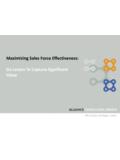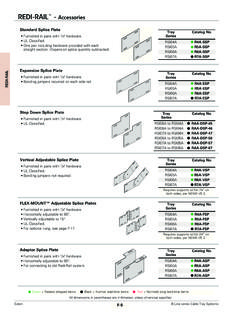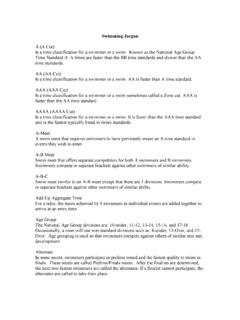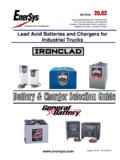Transcription of 'Stability Analysis Of Voltage-Feedback Op Amps,Including ...
1 StabilityAnalysisofVoltage FeedbackOpAmpsIncludingCompensationTechn iquesMarch 2001 Mixed Signal ProductsApplicationReportSLOA020 AIMPORTANT NOTICET exas Instruments and its subsidiaries (TI) reserve the right to make changes to their products or to discontinueany product or service without notice, and advise customers to obtain the latest version of relevant informationto verify, before placing orders, that information being relied on is current and complete. All products are soldsubject to the terms and conditions of sale supplied at the time of order acknowledgment, including thosepertaining to warranty, patent infringement, and limitation of warrants performance of its products to the specifications applicable at the time of sale in accordance withTI s standard warranty.
2 Testing and other quality control techniques are utilized to the extent TI deems necessaryto support this warranty. Specific testing of all parameters of each device is not necessarily performed, exceptthose mandated by government are responsible for their applications using TI order to minimize risks associated with the customer s applications, adequate design and operatingsafeguards must be provided by the customer to minimize inherent or procedural assumes no liability for applications assistance or customer product design. TI does not warrant or representthat any license, either express or implied, is granted under any patent right, copyright, mask work right, or otherintellectual property right of TI covering or relating to any combination, machine, or process in which suchproducts or services might be or are used.
3 TI s publication of information regarding any third party s productsor services does not constitute TI s approval, license, warranty or endorsement of information in TI data books or data sheets is permissible only if reproduction is withoutalteration and is accompanied by all associated warranties, conditions, limitations and notices. Representationor reproduction of this information with alteration voids all warranties provided for an associated TI product orservice, is an unfair and deceptive business practice, and TI is not responsible nor liable for any such of TI s products or services with statements different from or beyond the parameters stated by TI forthat product or service voids all express and any implied warranties for the associated TI product or service,is an unfair and deceptive business practice, and TI is not responsible nor liable for any such see.
4 Standard Terms and Conditions of Sale for Semiconductor Products. Address:Texas InstrumentsPost Office Box 655303 Dallas, Texas 75265 Copyright 2001, Texas Instruments Incorporatediii stability Analysis of Voltage-Feedback Op AmpsContents1 Introduction1.. 2 Development of the Circuit Equations3.. 3 Internal Compensation7.. 4 External Compensation, stability , and Performance14.. 5 Dominant-Pole Compensation15.. 6 Gain Compensation18.. 7 Lead Compensation18.. 8 Compensated Attenuator Applied to Op Amp21.. 9 Lead-Lag Compensation23.
5 10 Comparison of Compensation Schemes25.. 11 Conclusion26.. 12 Reference26.. List of Figures1 feedback System Block Diagram3.. 2 feedback Loop Broken to Calculate Loop Gain4.. 3 Noninverting Op Amp4.. 4 Inverting Op Amp5.. 5 Inverting Op Amp: feedback Loop Broken for Loop Gain Calculation6.. 6 Miller Effect Compensation7.. 7 TL03X Frequency and Time Response Plots8.. 8 Phase Margin and Percent Overshoot Versus Damping Ratio9.. 9 TL07X Frequency and Time Response Plots10.. 10 TL08X Frequency and Time Response Plots11.. 11 TLV277X Frequency Response Plots12.
6 12 TLV227X Time Response Plots13.. 13 Capacitively-Loaded Op Amp15.. 14 Capacitively-Loaded Op Amp With Loop Broken for Loop Gain (A ) Calculation15.. 15 Possible Bode Plot of the Op Amp Described in Equation 2316.. 16 Dominant-Pole Compensation Plot17.. 17 Gain Compensation18.. 18 Lead-Compensation Circuit19.. 19 Lead-Compensation Bode Plot19.. 20 Inverting Op Amp With Lead Compensation20.. 21 Noninverting Op Amp With Lead Compensation21.. 22 Op Amp With Stray Capacitance on the Inverting Input21.. 23 Compensated Attenuator Circuit22.. 24 Compensated Attenuator Bode Plot23.
7 25 Lead-Lag Compensated Op Amp23.. 26 Bode Plot of Lead-Lag Compensated Op Amp24.. 27 Closed-Loop Plot of Lead-Lag Compensated Op Amp25.. ivSLOA020A1 stability Analysis of Voltage-Feedback Op AmpsIncluding Compensation TechniquesRon ManciniABSTRACTThis report presents an Analysis of the stability of Voltage-Feedback operational amplifiers(op amps) using circuit performance as the criteria to attain a successful design. Itdiscusses several compensation techniques for op amps with and without IntroductionVoltage- feedback amplifiers (VFA) have been with us for about 60 years, and theyhave been a problem for circuit designers since the first day.
8 You see, thefeedback that makes them versatile and accurate, also has a tendency to makethem unstable. The operational-amplifier (op amp) circuit configuration uses ahigh-gain amplifier whose parameters are determined by external feedbackcomponents. The amplifier gain is so high, that without these external feedbackcomponents, the slightest input signal would saturate the amplifier output. Theop amp is in common usage, so this configuration is examined in detail, but theresults are applicable to many other voltage feedback circuits. Current feedbackamplifiers (CFA) are similar to VFAs, but the differences are important enough towarrant CFAs being handled in a separate application , as used in electronic circuit terminology, is often defined as achievinga nonoscillatory state.
9 This is a poor, inaccurate definition of the word. Stabilityis a relative term, and this situation makes people uneasy because relativejudgments are exhaustive. It is easy to draw the line between a circuit thatoscillates and one that does not oscillate, so we can understand why somepeople believe that oscillation is a natural boundary between stability circuits exhibit poor phase response, overshoot, and ringing longbefore oscillation occurs, and these effects are considered undesirable by circuitdesigners.
10 This application note is not concerned with oscillators; thus, relativestability is defined in terms of performance. By definition, when designers decidewhat tradeoffs are acceptable they determine what the relative stability of thecircuit is. A relative- stability measurement is the damping ratio ( ) and thedamping ratio is discussed in detail in Reference 1. The damping ratio is relatedto phase margin, hence, phase margin is another measure of relative most stable circuits have the longest response times, lowest bandwidth,highest accuracy, and least overshoot.
















